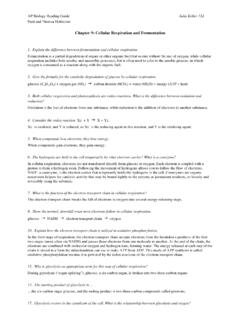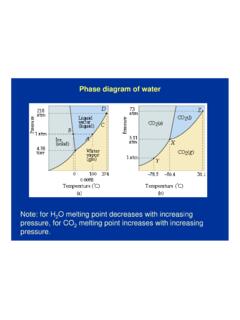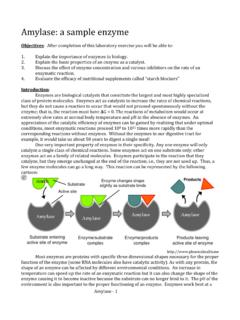Transcription of Chapter 11: Cell Communication - Biology E-Portfolio
1 AP Biology Reading Guide Julia Keller 12d Fred and Theresa Holtzclaw Chapter 11: Cell Communication 1. What is a signal transduction pathway? A signal transduction pathway is the series of steps by which a signal from outside the cell is converted (transduced) into a functional change within the cell. 2. How does yeast mating serve as an example of a signal transduction pathway? Yeast cells use chemical signaling to identify cells of opposite mating type (a and ) and initiate the mating process. 3. Complete the chart of local chemical signaling in cell Communication in animals. Local Signaling Types Specific Example paracrine numerous cells can simultaneously receive and respond to molecules of growth factor (consisting of compounds that stimulate nearby target cells to grow and divide) produced by a single cell in their vicinity synaptic an electrical signal along a nerve cell triggers the secretion of neurotransmitter molecules carrying a chemical signal that diffuse across the synapse, triggering a response in a target cell 4.
2 How does a hormone qualify as a long-distance signaling example? In endocrine signaling (hormonal signaling in animals), hormone molecules are released by specialized cells , which travel to other parts of the body through the circulatory system to reach target cells that recognize and respond to the hormones. Plant hormones (plant growth regulators) sometimes travel in vessels but more often reach their targets by moving through cells or by diffusing through the air as a gas. 5. A signal transduction pathway has three stages. Explain each step. ! During reception, the target cell s detection of a signaling molecule coming from outside the cell, a chemical signal is detected when the signaling molecule binds to a receptor protein located at the cell s surface or inside the cell. During transduction, the signal is converted to a form that can bring about a specific cellular response.
3 The binding of the signaling molecule changes the receptor protein in some way, initiating the second stage. The specific cellular response triggered by the transduced signal may be almost any imaginable cellular activity. 6. What is a ligand? A ligand is a molecule that specifically binds to another molecule, often a larger one. Ligand binding generally causes the receptor protein to undergo a chance in shape. 7. What is a G protein-lined receptor? Describe the role of the three components in the first stage. ! A G protein-coupled receptor (GPCR) is a cell-surface transmembrane receptor that works with the help of a G protein, a protein that binds the energy-rich molecule GTP. GPCRs vary in the binding sites for their signaling molecules (ligands) and also for different types of G proteins inside the cell. In the first stage, the G protein is loosely attached to the cytoplasmic side of the membrane, where it functions as a molecular switch that is either on or off, depending on which of two guanine nucleotides is attached, GDP or GTP.
4 When GDP is bound to the G protein, the G protein is inactive. The receptor and G protein work together with another protein, usually an enzyme. 8. Describe what happens in the second stage. ! When the appropriate signaling molecule binds to the extracellular side of the receptor, the receptor is activated and changes shape. Its cytoplasmic side then binds an inactive G protein, causing a GTP to displace the GDP. This activates the G protein. 9. Describe what happens in the third stage. ! The activated G protein dissociates from the receptor, diffuses along the membrane, and then binds to an enzyme, altering the enzyme s shape and activity. Once activated, the enzyme can trigger the next step leading to a cellular response. Binding of signaling molecules is reversible. 10. Describe how the signal is halted. ! The G protein also functions as a GTPase enzyme: it hydrolyzes its bound GTP to GDP.
5 Now inactive again, the G protein leaves the enzyme, which returns to its original state. The G protein is now available for reuse. 11. What activates a G protein? A G protein is activated when the cytoplasmic side of the GPCR binds an inactive G protein, causing a GTP to displace the GDP. 12. A G protein is also a GTPase enzyme. Why is this important? The GTPase function of the G protein allows the pathway to shut down rapidly when the signaling molecule is no longer present. 13. The second type of receptor described is receptor tyrosine kinase. Explain what a kinase enzyme does. A kinase is an enzyme that catalyzes the transfer of phosphate groups. The part of the receptor protein extending into the cytoplasm functions as a tyrosine kinase, an enzyme that catalyzes the transfer of a phosphate group from ATP to the amino acid tyrosine on a substrate protein.
6 14. How does tyrosine kinase function in the membrane receptor? Tyrosine kinases are membrane receptors that attach phosphates to tyrosines. 15. What is a key difference between receptor tyrosine kinases and G protein-coupled receptors? One receptor tyrosine kinase complex may activate ten or more different transduction pathways and cellular responses. Often, more than one signal transduction pathway can be triggered at once. The ability of a single ligand-binding event to trigger so many pathways is a key difference between receptor tyrosine kinases and G protein-coupled receptors. 16. Explain what happens in the first step. ! Before the signaling molecule binds, the receptors exist as individual units referred to as monomers. Each has an extracellular ligand-binding site, an helix spanning the membrane, and an intracellular tail containing multiple tyrosines.
7 17. Describe what happens to receptors tyrosine kinases when signaling molecules have attached. ! The binding of a signaling molecule causes two receptor monomers to associate closely with each other, forming a complex known as a dimer (dimerization). 18. Explain how the receptors are activated in the third step. ! Dimerization activates the tyrosine kinase region of each monomer; each tyrosine kinase adds a phosphate from an ATP molecule to a tyrosine on the tail of the other monomer. 19. Explain how the activated receptor can stimulate multiple cellular response pathways. ! Once the receptor is fully activated, it is recognized by specific relay proteins inside the cell. Each such protein binds to a specific phosphorylated tyrosine, undergoing a resulting structural change that activates the bound protein. Each activated protein triggers a transduction pathway, leading to a cellular response.
8 21. What are ion channel receptors? ! Ligand-gated ion channels are a type of membrane receptor containing a region that can act as a gate when the receptor changes shape. When a signaling molecule binds as a ligand to the receptor protein, the gate opens or closes, allowing or blocking the flow of specific ions through a channel in the receptor. 22. Explain what has happened with the binding of the ligand to the receptor. ! When the ligand binds to the receptor and the gate opens, specific ions can flow through the channel and rapidly change the concentration of that particular ion inside the cell. This change may directly affect the activity of the cell. 23. The ligand attachment to the receptor is brief. Explain what happens as the ligand dissociates. ! When the ligand dissociates from the ligand-gated ion channel, the gate closes and the ions no longer enter the cell.
9 24. In what body system are ligand-gated ion channels and voltage-gated ion channels of particular importance? Ligand-gated ion channels and voltage-gated ion channels (gated ion channels controlled by electrical signals instead of ligands) are crucial to the functioning of the nervous system. 26. This diagram uses testosterone, a hydrophobic hormone, to detail how intracellular receptors work. ! Intracellular receptors are found in either the cytoplasm or nucleus of target cells , where they bond to chemical messengers that are either hydrophobic enough (steroids, thyroid hormones) or small enough (nitric acid) to cross the hydrophobic interior of the membrane. [1] The steroid hormone testosterone passes through the plasma membrane. [2] Testosterone binds to a receptor protein in the cytoplasm, activating it. [3] The hormone-receptor complex enters the nucleus and binds to specific genes.
10 [4] The bound protein acts as a transcription factor, stimulating the transcription of the gene into mRNA. [5] The mRNA is translated into a specific protein. 27. Explain the function of transcription factors in the cell. Special proteins called transcription factors control which genes are turned on (and thus transcribed into mRNA) in a particular cell at a particular time. 28. What are two benefits of multistep pathways? Firstly, multiple steps may greatly amplify a signal. If some of the molecules in a pathway transmit the signal to numerous molecules at the next step in the series, the result can be a large number of activated molecules at the end of the pathway. Secondly, multi-step pathways provide more opportunities for coordination and regulation than do simpler systems, allowing for greater fine-tuning of the response.















